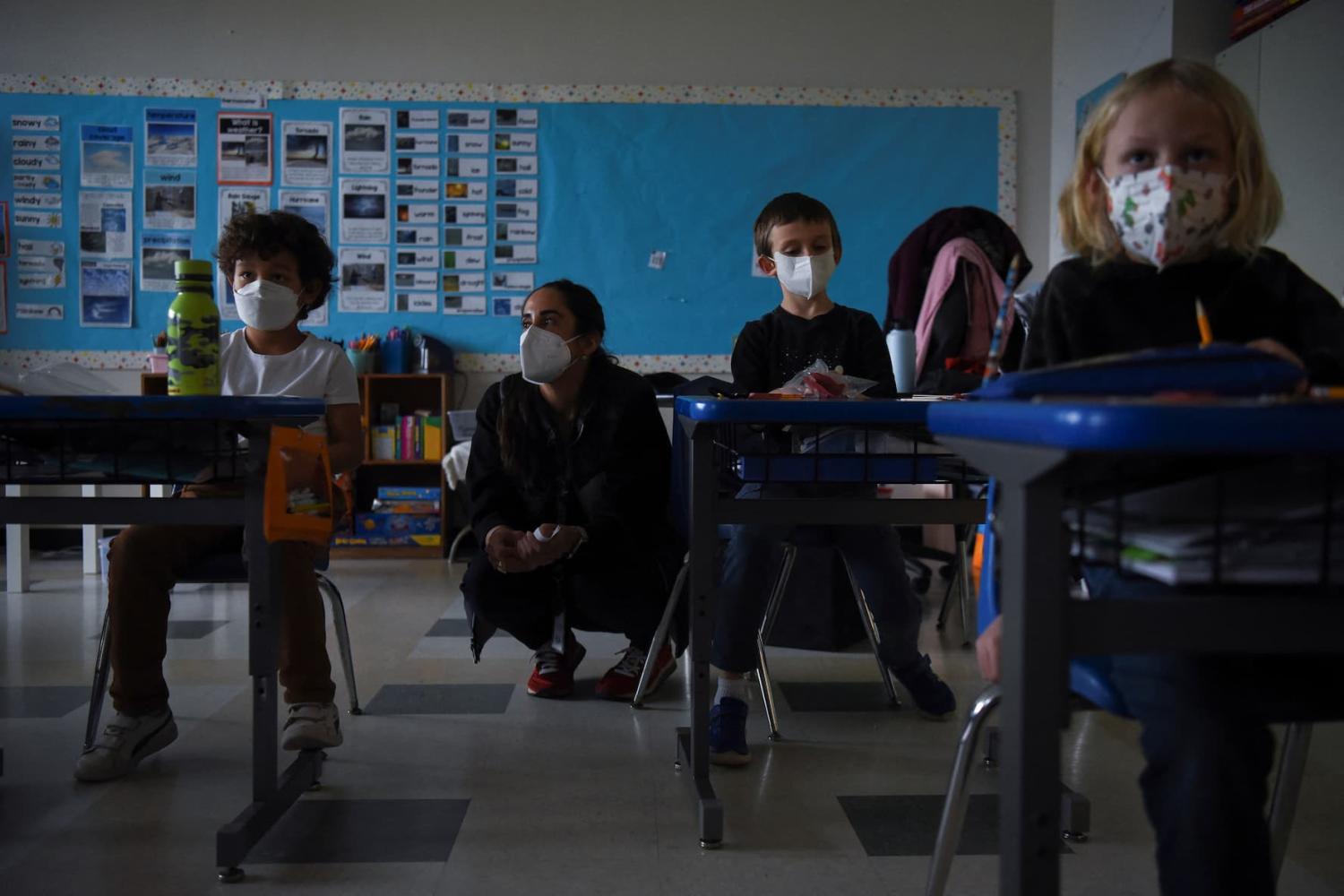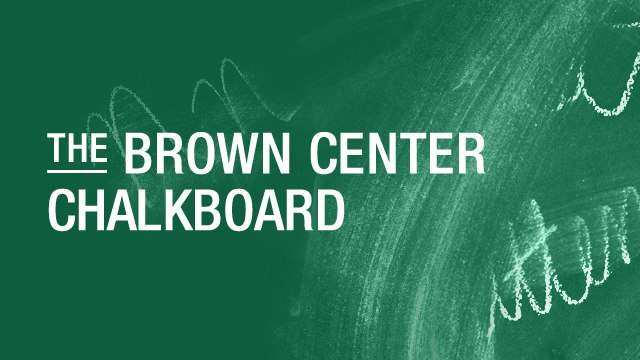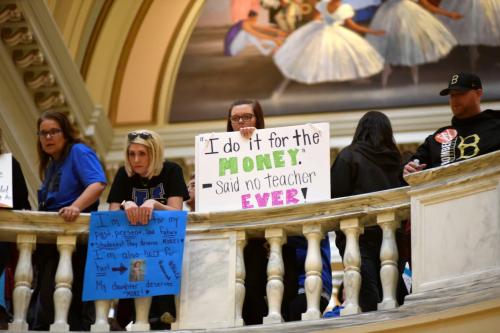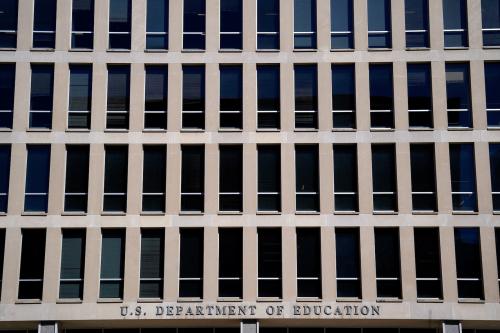Over the COVID-19 pandemic and its aftermath, labor shortages have garnered considerable attention, including among public school teachers. Nationwide, the teacher shortage exceeds 55,000 unfilled positions, with nearly five times as many positions held by underqualified candidates. These gaps have been generated, in part, by increased pandemic-era teacher turnover and a 35% enrollment decline in traditional university teacher preparation programs in the decade preceding the pandemic. Meanwhile, interest, prestige, and satisfaction related to the teaching profession have reached 50-year lows.
In response, individual states and the federal government have proposed and enacted various policies to strengthen the teacher workforce. These policies vary widely in scope, encompassing both financial interventions (e.g., teacher pay, loan forgiveness) and non-pecuniary policies around teacher working conditions. While debate over the depths and distribution of the teacher shortage continues, public opinion of enacted and mooted policy approaches varies widely. In this context, improved understanding of public support may inform voter-conscious policymaking, especially in contexts where the effects of policies intended to attract teachers may extend beyond school walls and in instances where policy enactment requires direct voter approval.
To explore public sentiment concerning several teacher recruitment and retention policies, we fielded four questions on the fall 2022 Cooperative Election Study (CES) surveys, which were administered to a nationally representative sample of U.S. adults. While many respondents support the proposed strategies, including teacher bonuses, grants, loan forgiveness, and shortened school weeks, significant partisan differences remain evident.
Public opinion in a partisan era
Policies to improve teacher recruitment and retention vary in scope; some specifically target teachers while others focus on broader economic incentives. We posed four survey questions capturing support for the following policies: 1) Expanding the federal Teacher Education Assistance for College and Higher Education (TEACH) Grant from $4,000 to $8,000; 2) Accelerating federal loan forgiveness programs (e.g., the Public Service Loan Forgiveness Program, the Teacher Loan Forgiveness Program, Perkins Loan Cancellation); 3) Enacting permanent four-day school weeks (4DSWs); 4) Distributing one-time teacher bonuses between $1,000 and $5,000.
The first two proposals focus on potential federal policies to recruit and retain teachers (and broader loan relief objectives) while the latter two proposals focus on state and district approaches to teacher labor markets, primarily addressing teacher retention.
Though the two federal policies may not be predicated directly on their public support, both have garnered significant national debate; the doubling of the TEACH grant stalled through President Biden’s American Families Plan proposal while loan forgiveness remains mired in long-term legal proceedings. Conversely, state and local policies often require direct voter support, either through local school board elections or referenda. Four-day school week policies have grown rapidly, primarily in rural locales, though recent evidence indicates largely negative impacts on student academic outcomes, while questions about their effects on parents, families, and communities remain. Teacher grants and bonuses have proliferated through COVID-19 federal relief funds, a revenue source soon due to expire.
While the efficacy of these policies to stabilize teacher labor markets may vary, our focus lies not in assessing their effectiveness but rather in documenting their public support to inform the feasibility of their enactment and sustainability through public buy-in. The pertinent portions of the CES surveys—which we partnered with YouGov to administer to a national stratified sample of approximately 1,000 adults—queried respondents on their support and opposition to these policies, also collecting their demographic characteristics (e.g., race, income, employment status), and political ideology, factors previously linked to policy support. Each question was contextualized for respondents as a potential tool to improve teacher recruitment and retention.
Polarization and partisanship frequently predict policy preferences, eclipsing demographic factors like age, race, and ethnicity, and even material self-interest. Combined with rhetoric from political leaders, partisanship can lead voters to oppose policies from which they stand to benefit. In our increasingly polarized political environment, Americans often view members of the other political party with distrust, which can lead voters to oppose policies based on political endorsements and to impede goals of the other political party. Thus, we expect partisanship to influence respondents’ preferences regarding education policy, particularly on politicized issues.
Contemporary public opinion on teacher shortage policies
On the one hand, each policy proposal garnered at least a plurality of public support. One-time bonuses (63.6%) and grants to teach in high-need schools (59.4%) were most popular; expanded loan forgiveness (47.3%) and permanent 4DSWs (40.7%) received more limited support (see Figure 1). In addition, support for each policy outstripped opposition by between 10 (4DSWs) to as many as 50 percentage points (one-time bonuses); between two and three in 10 respondents remained unsure of their support for each policy.
On the other hand, significant partisan variation underlies this support. Whereas most liberals support enacting each tactic (between 59.1% and 87.6%), only a plurality of conservatives supported one-time bonuses and a majority disapproved of the remaining strategies (see Figure 2). In fact, only slightly more than one in four conservatives indicated support for expanded loan forgiveness (26.0%) and 4DSWs (27.4%).
Only a few additional characteristics beyond partisanship predicted respondent preferences. Racial minority respondents and those holding a bachelor’s degree each indicated greater support for grants to teach in high-need schools. Additional characteristics like family income, gender, employment status, urbanicity, and age rarely, if ever, predicted policy preferences.
Situating our findings
Recently, scholars have explored partisan sorting in education, showing increasing polarization in education-focused topics, including in familiar debates concerning Common Core State Standards, public school quality, and education spending. Our findings showing partisan differences in support for these policy ideas are not entirely surprising, as some topics in education policy have become well-publicized, polarizing hot-button issues (e.g., ESAs, COVID-19 protection measures, book content, instruction discussing sex, gender orientation, and race and ethnicity).
Republican trust in institutions has been declining for several years. A summer 2023 Gallup poll shows a 34-point partisan gap in confidence in public schools, second only to the gap in confidence in the presidency. Affective partisanship and rhetoric from Republican elites also seems to have impacted Republican views of higher education. For example, a Pew Research Center survey illustrates a rapid decline in the number of Republicans who believe higher education has a positive effect “on the way things are going in the country,” declining from more than half in 2015 to only one in three in 2019. We find that these polarized views impact support for policy issues in education that have yet to feature in the so-called culture wars.
Teacher salaries: The annual Education Next Survey explores many hot-button education-focused topics ranging from perceptions of school quality to preferences for the enactment of new policies and practices. In 2022, responses to queries regarding the trajectory of teacher salaries varied widely by partisan ideology, with 70% of Democrats versus 46% of Republicans generally supporting salary increases.
The cost of education: Loan forgiveness and free two- and four-year college: Consistent with our findings, other survey results regarding loan relief showed a significant partisan divide. While 47% of Americans support some federal loan forgiveness, results from the Quinnipiac University Poll indicate a large partisan divide, with 88% of Democrats indicating approval and 81% of Republicans signaling disapproval. Similar partisan differences emerged in EdNext’s questions regarding free two- and four-year higher education, with Democrats indicating much stronger support (84% and 80%) than Republicans (44% and 36%).
Four-day school weeks: Though we found the least support for 4DSW policies (40.7%), the PDK International Poll recently indicated 53% support 4DSWs, up from 25% two decades ago. The PDK poll motivated 4DSWs with district cost savings whereas our question prioritized teacher recruitment and retention, which district leaders now typically cite as a primary objective of the policy and teachers value as a job perk.
The 2023-24 school year and beyond
As students begin the 2023-24 school year, many will return to schools either under-staffed or staffed, in part, by underqualified teachers, making post-pandemic academic recovery more challenging. Though we find a plurality of adults support a range of teacher recruitment and retention policies, even seemingly politically neutral strategies to address teacher shortages may now court a partisan divide similar to other issues in contemporary education policy, one which may feature prominently in upcoming elections. As a result, the feasibility of implementing local policies like 4DSWs and one-time teacher bonuses may hinge on the direction of local partisanship, while federal policies like loan relief may continue to languish with single-party support.
The Brookings Institution is committed to quality, independence, and impact.
We are supported by a diverse array of funders. In line with our values and policies, each Brookings publication represents the sole views of its author(s).










